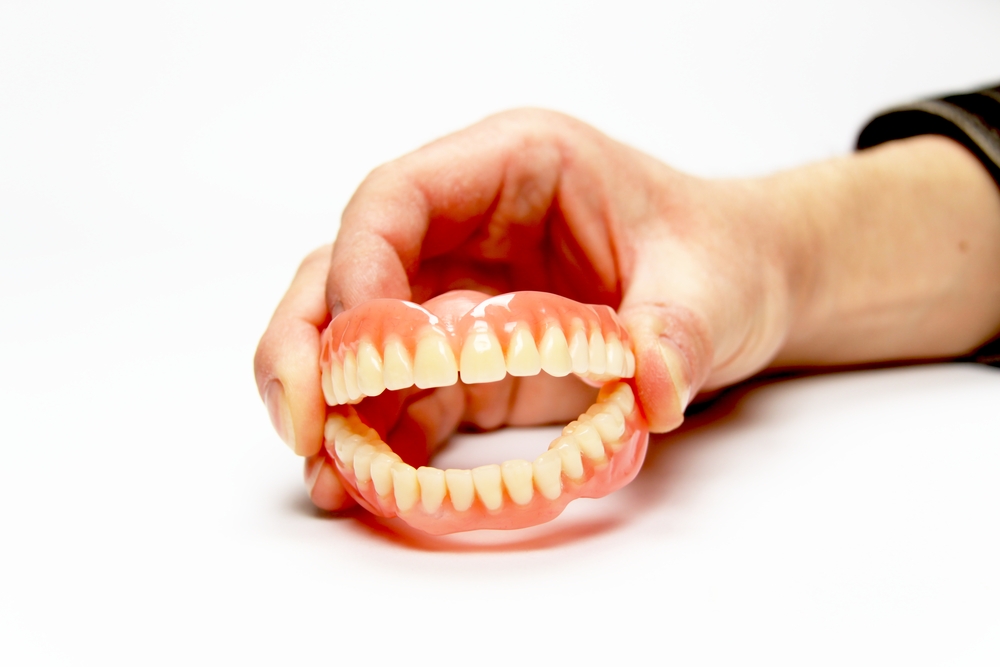Implants and Your Dentures: What’s the Story?
21 Feb 2017
With an aging population, the need for a predictable and long term solution for missing teeth has driven a radical change in how teeth are replaced, especially in the case of dentures. First, let’s take a look back at how far we’ve come!
The earliest known dentures were made by the Egyptians around 1500 BC. They were made from human teeth wired together and tied to the adjacent teeth. Pretty clever! Later the Etruscans did the same using a combination of teeth and hippo ivory to make their dentures. Hippo ivory! Every Etruscan’s dream.
With an increasingly sugary diet, the need for dentures grew and the solutions became very creative. Human teeth were the most popular choice for dentures, but, as you can imagine, they weren’t all that easy to come by. Teeth were gotten by grave robbery, extraction from execution victims, and procurement from the unfortunate poor who were so desperate for money, they would sacrifice their own teeth. Hygiene practices, being what they were, didn’t account for the cause of death of some of the victims and things like syphilis were able to be contracted by the new owner of the teeth. Bonus buy!
Luckily, along came the battle of Waterloo in 1815 that killed tens of thousands of soldiers. It was the ultimate denture making dream. People were paid to visit the battlefields and collect the veritable treasure trove of free teeth. Disgusting, right? The teeth were then riveted into animal ivory and sold to the upper crust as ‘Waterloo teeth.’ Marketing at its finest.
Around 1820, Claudius Ash upped the ante in denture making by doing away with human teeth and using gold with a porcelain coating, which he attached using swivels and springs. It was like the Tesla automobile of teeth, at the time. He then devised a way to set the teeth in vulcanized dental rubber.
The twentieth century saw the rise of popularity of acrylics and resins, but the basic design of the denture–replacement teeth set in a moveable base that sat atop the toothless ridge–really hadn’t changed since the 1700’s. Enter the implant.
In the 1960’s Per Ingvar Branemark, a Swedish orthopedic surgeon, developed the titanium implant, which is basically a tooth root replacement and it has revolutionized how dentures function. Read how!
How Does a Denture Work?
To understand what a denture really does, let’s take a quick look at the jaws and teeth. The jaws consist of a bony base–called the maxilla on the upper and the mandible on the lower. Growing from the base are two plates of bone that form the socket that holds the teeth in place. These together are called the alveolar process. You can run your finger along your tooth roots to feel the alveolar bone.
The alveolar process’ entire function is to support the teeth, and once the tooth is removed, it begins to break down or resorb. Imagine that all the teeth are removed. What will remain is the base bone and the sockets made of the alveolar bone. This is called the alveolar or residual ridge. So, a denture is basically just an acrylic base that fits over the ridge with false teeth set into it.
There is a large difference in how a denture functions on the top and how it functions on the bottom, though. Let’s examine the reasons.
Upper Denture
The upper ridge takes much longer to resorb. That means the denture can fit for a long time without many modifications. The roof of the mouth (palate) is used to generate suction in an upper denture, giving it great retention and little movement. The upper jaw is fixed so it doesn’t move. So, we have
- Long lasting ridge
- Suction
- Beneficial muscular forces
Lower Denture
In contrast, the lower ridge, upon which the denture sits, resorbs 4 times faster than the upper one. The tongue sits in the middle of the ridges and moves. The lower jaw is moveable. So we have
- Ridge that changes quickly
- Dentures don’t fit for long
- No suction
- Muscular forces displace denture
Now, at its finest, a lower denture can only provide roughly 30% of the function of a ridge with natural teeth. That’s pretty disappointing. Because the lower denture is easily moved, the pattern of chewing must be altered to keep from displacing it, and harder tougher foods can’t be eaten well.
The Problem with Traditional Dentures

In many cases, the upper denture can function very well, but acrylic covers the roof of the mouth diminishing tastes and the pleasurable sensation of eating. The lower denture has proven to be an inadequate restoration. The bone resorbs quickly and is not replaceable once it has gone. With bone loss comes a collapsing of the facial features, which can have devastating effects on appearance. This presents a lot of problems for the denture wearer!
- Pain
- Poor performance
- 30% of natural tooth function
- Discomfort
- Continuing bone loss
- Altered appearance of face
- Aging effect
- Loss of options
How Can Implants Improve Your Denture?
Finally, the exciting part! Thanks to implants, the wobbly lower denture and the quickly disappearing bone are a thing of the past. Remember, the alveolar bone disappears when the tooth is removed, because it no longer has a root to stimulate it. The implant, or root replacement, actually allows for the continued stimulation of bone, thus preventing resorption. Great news! Not only that, but the implants allow for a variety of ways to actually anchor the denture to the implants allowing for normal chewing, again. Function is restored to about 95%. So, with an implant supported denture we have
- Bone sparing
- Facial contours remain the same
- Excellent performance
- 95% of natural tooth function
- Anchorage preventing displacement by chewing forces
- Upper dentures don’t have to cover palate
What are the Options for an Implants and a Denture?
There are different ways to restore your smile with a combination of implants and dentures. Your dentist will advise you which solutions make the most sense for you. Let’s take a closer look at the different technologies available. There are two basic categories of dentures used in conjunction with implants.
- Implant Assisted Dentures – Implant assisted dentures usually use 2 – 4 implants to stabilize and secure the denture. This type of restoration still relies on the bone and tissues of the mouth. It usually consists of attachments on the inside of the denture that snap onto the implants or a bar attached to implants in the mouth. The components are changed out regularly to keep retention.
- Pros
- Can utilize fewer implants
- Less surgery
- Lower cost
- Easily cleansable
- Cons
- Not as solid
- Relies on bone and tissue
- Removable
- Frequent replacement of components
- Pros
- Implant Supported Dentures – Implant supported dentures usually use from 4 – 8 implants to support the denture. The denture relies only on the implant for its support and offers options to permanently secure the denture to the implants.
- Pros
- Most stable
- Offers options for fixed dentures that do not come out
- Function like natural teeth
- Very little maintenance
- Increased comfort
- Function
- Cons
- Requires more implants
- More surgery
- Increased cost
- Can be more difficult to clean
A Closer Look at Fixed Implant Supported Dentures
A fixed implant supported denture is one which is permanently anchored to the implants. This means, your dentist will place the final denture in your mouth and it will not come in and out. This can be accomplished several ways.
- Hybrid denture – a hybrid denture consists of a bar that attaches to the implants embedded within a traditional acrylic denture. This type of restoration requires a minimum of four implants
- Fixed denture – this type of denture requires more implants and a framework is made, like a conventional dental bridge, that attaches directly to the implants.
What About Teeth in a Day?
You’ve no doubt hear about teeth in a day. This option can be used for some people with a failing dentition providing there is enough bone. This option utilizes four to six implants on the top and usually four implants on the lower. After multiple appointments for measurements, and treatment planning, the teeth will be extracted and implants placed immediately. A temporary denture will be placed at the time of surgery and will be replaced after a period of healing. This is exciting technology for patients who are candidates.
How Do I Know if Implants are Right for Me?

If you are wearing a denture without implants, talk to your dentist about options for you. Lower dentures, especially, are vastly improved with as few as two implants. Your dentist and surgeon will look at factors such as
- How much bone is available
- How much bone is lost
- Medical Conditions
- Diabetes
- Smoking
- Osteoporosis
- Radiation to jaws
To determine the best course of action for you. Nowadays, there are very few people who can’t have implants. With 3D CT scans that can image vital structures such as vessels and nerves, precise surgical planning and placement is possible. New grafting techniques have made implants possible where they weren’t just a few years ago.
Dentures have come a long way! Talk to your dentist about the best way to maximize the technology for you!
Related Blog Articles